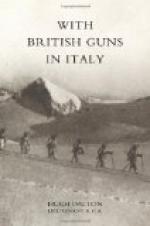German propaganda was insidiously active in Italy throughout the war, and spread many lying stories with the object of discrediting the British. Among these was one, the details of which do not matter now, concerning the fact that only British Artillery, and no British Infantry, had at that time been sent to Italy. Our Reconnaissances, involving our visible and daily presence among the gallant succession of Italian Brigades, who held the blood-stained line on the Carso and across the valley of the Vippacco, were the most fitting reply which we could make to German propaganda.
* * * * *
I made my first Front Line Reconnaissance on July 27th, two days after we had moved forward to our new Battery position. That day I visited the trenches on the Volconiac, starting in the early afternoon and getting back at nightfall. I took with me as a guide a young Italian gunner, a Neapolitan by birth, who had been a waiter in an Italian restaurant in New York before the war. He had been in the Austrian offensive of 1916 in the Trentino, where all the guns of his Battery had been lost and nearly all his comrades killed or captured.
From the Battery position we followed the road behind Hill 123, up a glorious valley, whose sides were thickly wooded with pines, gradually thinning under the destruction wrought by Austrian shell fire and the Italian military need for timber. The only other vegetation here was a little coarse grass. On the lee side of Hill 123, sheltered from Austrian fire, was a whole village of wooden huts, admirably constructed, capable of housing several Battalions. At the head of the valley, the road, a good example of the war work of the Italian Engineers, turned sharply up the hillside, securing tolerable gradients by means of constant zigzags—tolerable that is to say for men on foot and for pack mules, for wheeled transport could not proceed beyond this point. It was a steep climb and I perspired most visibly right through my thin tunic. Three-quarters of the way up we stopped and got a drink of water from the Infantrymen in charge of the water barrels. There are no springs or streams on the Volconiac or on Dosso Faiti. All water has to be pumped up from below through pipes, and at the point where we rested, water barrels were being continually filled from the pipes and then hauled on by hand, on sleighs, for the remainder of the ascent. Water was also carried up from this point by individual soldiers in the fiaschi, or glass bottles encased in plaited straw, in which Italian wine is sold.
Just below the crest we entered the trenches, which were held at this time by the Florence Brigade. The construction of these trenches was very interesting. They were all blasted in the rock, and many drilling machines were at work as I passed along them, increasing the number of caverne, or dug-outs, and deepening those already in existence. Here and there, where the trenches were rather shallow, they were built up with loose rocks and sandbags filled with stones.




